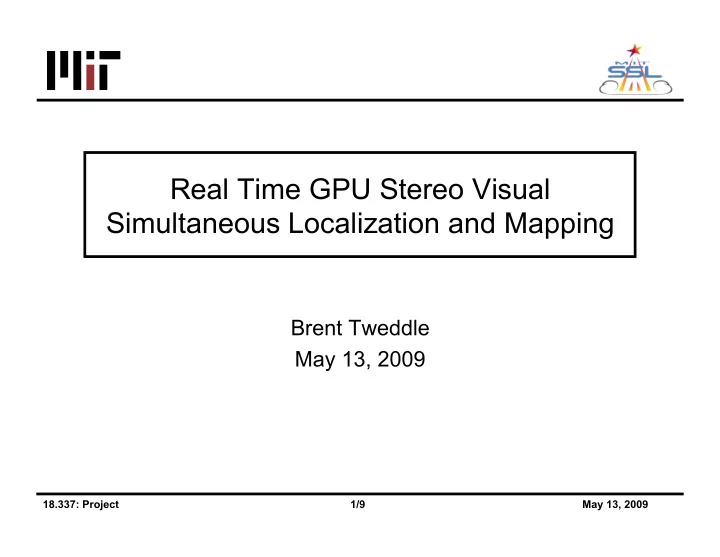

Real Time GPU Stereo Visual Simultaneous Localization and Mapping Brent Tweddle May 13, 2009 18.337: Project 1/9 May 13, 2009
Mobile Robotics: DGC • Darpa Grand Challenge vehicles represent the current state of the art in autonomous mobile robotics • 3 Steps performed Online – Navigation (Localization and Mapping) – Path Planning – Control 18.337: Project 2/9 May 13, 2009
Perception Video 18.337: Project 3/9 May 13, 2009
DGC Computing • Sensors: – 15 radars – 12 Single axis lidars – 1 rotating lidar – 5 cameras – GPS – Inertial measurement system • Computing – 10 Blade Cluster – Each Computer is Quad-Core 2.3 GHz Xeon – Total Power consumption: 4000W This power consumption is impractical for a large number of applications, especially aerospace robotics. 18.337: Project 4/9 May 13, 2009
GPU’s for Real Time Robotics Processor Theoretical Peak Watts Watts per GFLOPS GFLOPS Quad “Bloomfield” 25.6 GFLOPS 130 W 5.078 Xeon 3.2 GHz Core 2 Duo 20.2 GFLOPS 25 W 0.810 “Penryn” 2.53 GHz Cell Processor 152 GFLOPS 80 W 0.526 NVIDIA Tesla C870 518 GFLOPS 170 W 0.328 NVIDIA GeForce 504 GFLOPS 105 W 0.208 9800 GT NVIDIA GeForce 240 GFLOPS 35 W 0.145 8800M GTS • Assumptions: • Xeon issues 2 flops per cycle per core • Core2Duo issues 4 flops per cycle per core http://icl.cs.utk.edu/hpcc/hpcc_desc.cgi?field=Theoretical%20peak 18.337: Project 5/9 May 13, 2009
Current SLAM 18.337: Project 6/9 May 13, 2009
Proposed Algorithm • Stereo Visual SLAM – Using stereo cameras create a map of your environment and locate yourself within it • Grid Map • Algorithm Flow: – Dense Stereo Correspondence (18.337) – Scan Matching (Thesis) – Particle Filter Grid Map (Thesis) 18.337: Project 7/9 May 13, 2009
Stereo Correspondence Search Left Right Image Image Search Direction 18.337: Project 8/9 May 13, 2009
Dense Stereo Correspondence • Large body of work exists on dense stereo: – Scharstein, Szeliski “A Taxonomy and Evaluation of Dense Tow-Frame Stereo Correspondence Algorithms”, IJCV 2002 – Brown, Burschka, “Advances in Computational Stereo”, IEEE PAMI, 2003 • Optimized algorithms for CPU SIMD hardware (512x512: <0.1s) – Van der Mark, Gavrila, “Real-Time Dense Stereo for Intelligent Vehicles”, IEEE Trans. ITS, 2006 • Cuda Implementation by NVIDIA’s Joe Stam – Crude and no published timings 18.337: Project 9/9 May 13, 2009
Images, Pixels, Threads & Blocks Pixels Thread Thread Thread Thread Thread Thread Thread Block 18.337: Project 10/9 May 13, 2009
List of Improvements • Left-Right Consistency Check – Perform correspondence on both sides and check that results match • Naïve implementation doubles FLOPS – Implemented on the GPU by storing calculations in two 3D grids • Same number of FLOPS, but more memory is needed – Had to add additional kernel to avoid race conditions • Threshold for minimization to avoid disparity noise in textureless regions – New < Best-250 18.337: Project 11/9 May 13, 2009
Visual Results • Visually appears much more accurate • Runs in 25ms still less than – More than 16ms, but still less than most CPU implementations 18.337: Project 12/9 May 13, 2009
Performance Limitations • Algorithm is not memory bandwidth limited • However it is limited by: – Memory Latency – Multiprocessor Warp Occupancy • Compute 1.1, 20 registers, 80 bytes shared mem, 20 bytes constant mem • Register Limited 18.337: Project 13/9 May 13, 2009
Conclusion • GPU’s are a valid method to use for robotic navigation • Showed implementations of first step of navigation algorithm (accurate stereo vision) • Analyzed performance limitations of implementation and suggested future recommendations 18.337: Project 14/9 May 13, 2009
Recommend
More recommend